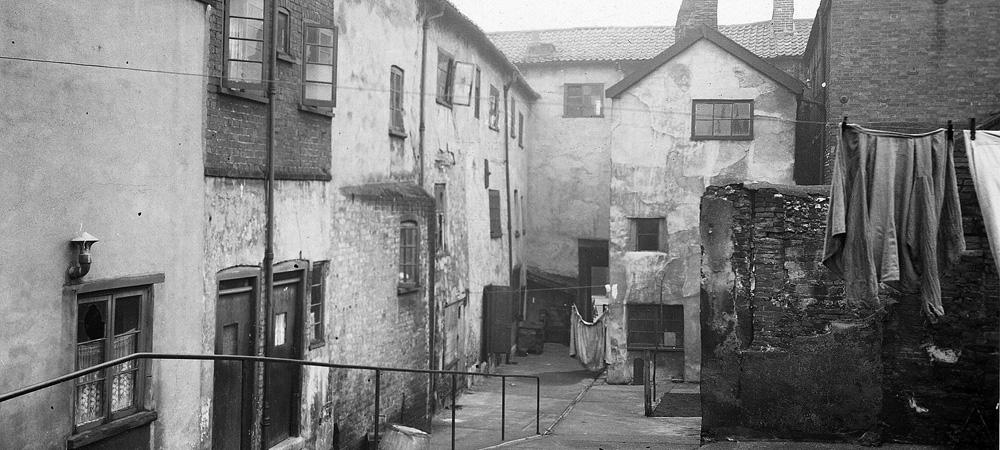Courts
and Yards
of Old
Norwich


In Norwich a typical old yard or court (the terms are interchangeable) was located behind an ancient building which fronted the street. It was entered through a narrow opening, often tunnel-like which led to a cul-de-sac. Around its perimeter were shoddy dwellings, often formed out of larger houses, which shared inadequate water supplies and toilets. Occupants living in yards suffered from both a lack of ventilation and dismal light.
The major problems experienced in yard properties arose from the fact that they had not been planned into the landscape - they were shoehorned behind older properties. The entrance to a yard would normally be by way of a narrow opening with properties generally built in a cul-de-sac formation. Such characteristics led to the major problems of the yards: they lacked light and ventilation. Often there was no water supply to the houses, the only water available to families was by means of a single pump in the yard. Privies would generally have been shared by a number of households. Many toilets did not flush and would consist of a “bin” covered with a toilet seat, which would be emptied once a week by specially commissioned refuse collectors. As such it is no wonder that when we asked people who lived in the yards if they knew of an item that characterised them, they simply said 'the smell'.
Despite such problems and although inhabitants may have had few material possessions the interior of houses would often be exceptionally clean and neat, which would have owed much to the hard work of the 'lady of the house' who would spend most of her day cleaning, washing and cooking. With no internal water supply, the weekly wash would have taken all day. The only break was to cook lunch (most families would come home for 'dinner' (lunch) which was the main meal of the day). To keep the house spotless some would even whitewash the kitchen walls as part of the weekly clean.
The courts & yards were not peculiar to Norwich, indeed they were common in major cities across Britain. However, aspects of Norwich's old yards give them distinct characteristics. Firstly because of Norwich's early wealth (built on a pre-industrial revolution textile trade) many yards can be traced back to Tudor and Stuart buildings. Secondly, many industrial cities built back-to- backs and terraces in open spaces to house their poorer citizens. Although this did happen in Norwich e.g. Crooks Place, Norwich builders continued to infil behind older properties well into the second half of the 19th century. Thirdly many yards were located adjacent to the many public houses located within Norwich (we had more than 450) which in turn gave them their often exotic names e.g. Queen of Hungary, or Arabian House - sadly conditions in the yards did not live up to such picturesque appellations.
Early programmes designed to improve living conditions in the old courts and yards failed to address a basic issue: people lived in the yards because they could not afford to live anywhere else, and until a viable alternative could be provided they would continue to be a major source of accomodation. To break the stalemate the government needed to intercede, but without the support of their electorate they were reluctant to act. However, WWI was a catalyst for change. Following the conflict the country demanded 'Homes Fit for Heroes'. In resoponse Norwich City Council began a council house building programme, building houses of exceptionally high quality e.g. the Mile Cross Estate. Unfortunately, rents for such properties were beyond the pockets of Yard dwellers, but in 1930 this all changed. For the first time, local government council house bulding programmes were not only linked with slum-clearance programmes but for the first time authorities could give rent rebates. In the following decade Norwich City Council undertook an extensive house building/ slum clearance programme. From 1930 until the outbreak of WWII slum clearance prgrammes undertaken in Norwich affected around 3,300 houses and 10,000 people: approximately half of both the people and properties affected were located in the yards. By the outbreak of the war although the worst of the yards had been cleared, many remained, with tenants sill living in unsatisfactory dwellings. However, post WWII work recommenced.
But what of the old courts and yards today? There are still numerous examples of the old yards around the City. These mainly fall into two categories: either ancient yards that have been renovated and refurbished e.g. Swan Yard (King Street); or a yard that has been cleared of its original housing which is reached through a narrow entrance which bears its name e.g. Loose's Yard on Magdalen Street.
Elsewhere new yards have been erected in the same area, sometimes on the same footprint, of an old yard. Some of the most poignant examples are where the old yards have been demolished but the names live on in new. modern social housing schemes. For example, the original Key & Castle Yard (Oak Street) has long been demolished. The community that lives in the new Key & Castle yard no longer occupy unsanitary, dilapidated accommodation but dwellings constructed from state-of-the-art materials, in comfort and security beyond the dreams of those long-ago residents.